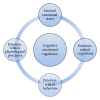Emotional Regulation and Depression: A Potential Mediator between Heart and Mind
- PMID: 25050177
- PMCID: PMC4090567
- DOI: 10.1155/2014/324374
Emotional Regulation and Depression: A Potential Mediator between Heart and Mind
Abstract
A narrative review of the major evidence concerning the relationship between emotional regulation and depression was conducted. The literature demonstrates a mediating role of emotional regulation in the development of depression and physical illness. Literature suggests in fact that the employment of adaptive emotional regulation strategies (e.g., reappraisal) causes a reduction of stress-elicited emotions leading to physical disorders. Conversely, dysfunctional emotional regulation strategies and, in particular, rumination and emotion suppression appear to be influential in the pathogenesis of depression and physiological disease. More specifically, the evidence suggests that depression and rumination affect both cognitive (e.g., impaired ability to process negative information) and neurobiological mechanisms (e.g., hypothalamic pituitary adrenal axis overactivation and higher rates of cortisol production). Understanding the factors that govern the variety of health outcomes that different people experience following exposure to stress has important implications for the development of effective emotion-regulation interventional approaches (e.g., mindfulness-based therapy, emotion-focused therapy, and emotion regulation therapy).
Figures



References
-
- Dohrenwend BS, Dohrenwend BP. Overview and prospects for research on stressful life events. In: Dohrenwend BS, Dohrenwend BP, editors. Stressful Life Events: Their Nature and Effects. New York, NY, USA: Wiley; 1974. p. p. 313.
-
- Kendler KS, Karkowski LM, Prescott CA. Causal relationship between stressful life events and the onset of major depression. The American Journal of Psychiatry. 1999;156(6):837–841. - PubMed
-
- Lazarus RS. Stress and Emotion: A New Synthesis. New York, NY, USA: Springer; 1999.
-
- Sarason IG, Johnson JH, Siegel JM. Assessing the impact of life changes: development of the life experiences survey. Journal of Consulting and Clinical Psychology. 1978;46(5):932–946. - PubMed
-
- McCarthy CJ, Lambert RG, Moller NP. Preventive resources and emotion regulation expectancies as mediators between attachment and college students’ stress outcomes. International Journal of Stress Management. 2006;13(1):1–22.
Publication types
LinkOut - more resources
Full Text Sources
Other Literature Sources

